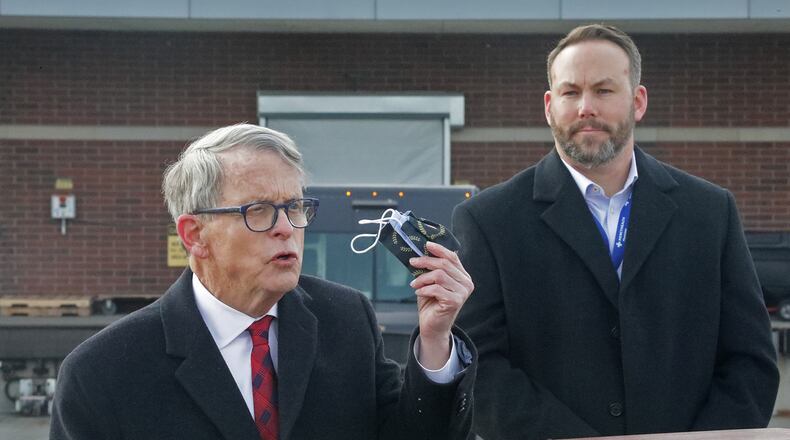“We are still working to determine the logistics of how the vaccines will be distributed,” he said.
Residents 65 and older comprise of nearly 87% of the coronavirus deaths in Ohio, DeWine said. About 1.8 million of Ohio’s population is ages 65 and up.
Though the state is still working on its plans to roll the vaccine out, the governor said it will likely be available in multiple places, such as doctor’s offices, pharmacies and other easily accessible places.
DeWine added that the state is making the vaccine available those who work in schools to help get the state back to in-person learning.
“We will offer vaccines to all schools that want to go back, or to remain, in person,” the governor said. “All adults in the schools would have the ability to get a vaccine. Our goal is to start this phase around the middle of January.”
He added that the state hopes all schools who want to resume or continue with in-person learning will be back in the classroom by March 1.
The next broad category of people eligible to be vaccinated will be older Ohioans age 65+. This chart shows that these Ohioans make up just under 87% of #COVID19 deaths in Ohio. We are still working to determine the logistics of how the vaccines will be distributed. pic.twitter.com/JQDkrZGDz5
— Governor Mike DeWine (@GovMikeDeWine) December 23, 2020
“This decision protects our most vulnerable and the silent victims of the virus: our kids,” Lt. Gov. Jon Husted said.
Currently, the state is in Phase 1A, which focuses on frontline health care workers and residents and staff in nursing homes and other long-term care facilities.
“It’s not going to be done over night,” DeWine said. “It’s going to take weeks and weeks, but we have a plan in place to get the job done.”
The governor noted that the different vaccination stages will likely overlap, noting that he wouldn’t be surprised if vaccinations at long-term care facilities are still taking place in March.
DeWine unveiled two new maps that show the spread of coronavirus and ICU utilization in Ohio over the last five months.
The maps will be updated each week and posted online on Thursdays.
New Map ➡ Cases Per Capita Over Time
— Governor Mike DeWine (@GovMikeDeWine) December 23, 2020
Even our counties with the highest incidence in August are lower than where our lowest counties are now. We designed this map to show you how your county compares to other counties. pic.twitter.com/aswqscHQOF
The first map shows the per capita by county. It uses the incidence rate of coronavirus per 100,000 residents, with yellow showing a lower rate and red showing a higher rate.
The second map measures ICU admissions by county and shows what percent of ICU patients have coronavirus. The darker the shade of blue, the higher the percentage of COVID-19 ICU patients.
“This gives us the opportunity to look at each county and see your risk of catching the virus and how many COVID patients are in your hospital system ICU,” DeWine said.
More than 100 coronavirus deaths were reported in Ohio for the second straight day Wednesday.
The stated recorded 109 deaths Wednesday and 130 on Tuesday, according to the state health department. There have been 8,361 total deaths reported in Ohio during the pandemic.
The date that deaths are reported do not reflect the day a patient died.
There were 7,790 daily cases reported in Ohio, bringing the total to 644,822. It’s the lowest patient count the state’s had in two weeks.
“This is below average for the last 21 days, but it’s still obviously at a very elevated level,” DeWine said.
Southwest Ohio also reported it’s lowest number of hospitalized coronavirus patients for the last two weeks with 1,138. COVID-19 patients account for 15.71% of hospitalizations in the region, with 2,367 (32.67%) beds available.
The region reported 255 coronavirus patients in ICUs, with 278 (24.39%) of beds open.
Hospitalizations increased by 431 for a total of 36,025.
There were 4,694 COVID-19 patients in Ohio’s hospitals on Wednesday, according to the Ohio Department of Health.
Ohio is continuing to ramp up vaccinations as the state receives more shipments of the Pfzier and Moderna vaccines.
As of Wednesday, 11,700 people have received the first of the two-shot vaccination in Ohio. Both the Moderna and Pfizer vaccine requires two doses.
Nearly 20,000 additional shots from Pfizer are expected to arrive on Christmas Eve. The doses will be distributed to Ohio hospitals that did not receive any vaccines from the state’s first shipment, according to the Ohio Department of Health.
Ohio is also starting the second phase of a federal program that vaccinates residents and staff at long-term care facilities with the help of pharmacies. Under the next phase, vaccinations will be administered at assisted living centers, residential care facilities and facilities for people with developmental disabilities.
About the Author

